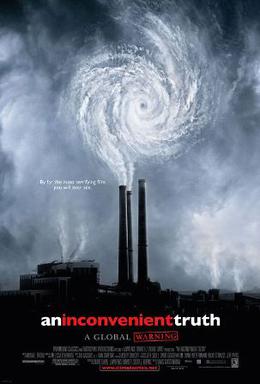
In Hot (not): a cold blast from the past, I commented on a news story that updated one of the key points of "An Inconvenient Truth," which I showed to my Environmental Science class this week. This week, three more of the key points in the movie made cameos in this week's news. Follow over the jump to read them.
Early on in the film, Al Gore described his first encounter with the Roger Revelle's research, in which he asked about the annual cycle of CO2. That phenomenon made news this week, as Richard Harris of NPR recounted in Swinging CO2 Levels Show The Earth Is 'Breathing' More Deeply on August 08, 2013 5:05 PM.
Plant life on our planet soaks up a fair amount of the carbon dioxide that pours out of our tailpipes and smokestacks. Plants take it up during the summer and return some of it to the air in the winter. And a new study shows that those "breaths" have gotten deeper over the past 50 years.Next, one of the major "so what" moments in the film was Gore's explanation of how warmer oceans would result in both more hurricanes and more powerful storms. That's predicted to happen again this year, as NOAA predicted the Atlantic hurricane season is on track to be above-normal on August 8, 2013.
This isn't just a curiosity. Plant life is helping to reduce the speed at which carbon dioxide is building up in our atmosphere. That's slowing the global warming, at least marginally, so scientists are eager to understand how this process works. The new study provides some clues.
If you look at the graph of carbon dioxide concentrations in the atmosphere, you'll notice that it has climbed sharply over the past five decades, from about 315 parts per million to 400 parts per million. But that's not the whole story.
"In addition to this steady increase caused by fossil fuel combustion and other human activities, there's a regular seasonal cycle of CO2 concentration," says Heather Graven, a postdoctoral researcher at the Scripps Institution of Oceanography.
NOAA issued its updated Atlantic hurricane season outlook today saying the season is shaping up to be above normal with the possibility that it could be very active. The season has already produced four named storms, with the peak of the season - mid-August through October - yet to come.Finally, Gore used the collapse of the Larsen B ice shelf as a canary in the coal mine for global warming. That's 11 year old news, but new findings can always be wrung out of old data, as Jane Qiu of Nature described in Chain reaction shattered huge Antarctica ice shelf on August 9, 2013.
"Our confidence for an above-normal season is still high because the predicted atmospheric and oceanic conditions that are favorable for storm development have materialized," said Gerry Bell, Ph.D., lead seasonal hurricane forecaster at NOAA's Climate Prediction Center, a division of the National Weather Service. "Also, two of the four named storms to-date formed in the deep tropical Atlantic, which historically is an indicator of an active season."
The conditions in place now are similar to those that have produced many active Atlantic hurricane seasons since 1995, and include above-average Atlantic sea surface temperatures and a stronger rainy season in West Africa, which produces wind patterns that help turn storm systems there into tropical storms and hurricanes.
Draining of meltwater lakes from surface explains sudden demise of Larsen B.The rapid draining resulted in a form of isostatic rebound, which produced a series of fractures around the lakes.
It took decades for global warming to slowly melt the surface of the Larsen B Ice Shelf on the Antarctic Peninsula, forming nearly 3,000 lakes. But at the end of the Antarctic summer of 2002, all the lakes drained away in the space of a week. And then the 2,700-square-kilometre ice shelf, which was some 220 metres thick and might have existed for some 12,000 years, rapidly disintegrated into small icebergs, leaving glaciologists scratching their heads.
It was “like the smashing of glasses at the throw of a stone”, University of Chicago geophysicist Douglas MacAyeal said last week at an International Glaciological Society meeting in Beijing.
Researchers have been wondering ever since what could have caused the sudden draining of the lakes, and whether this caused the demise of the ice shelf. Now, a study led by MacAyeal might answer both questions.
The worksheet on 'An Inconvenient Truth' has questions about all three topics.
1. What evidence first convinced Al Gore about the connection between carbon dioxide and global warming?I can share all these stories with my students on Tuesday, when I lecture on climate change. That will demonstrate that the film is still relevant six years after I began showing it to my classes.
...
4. Explain how the 2004-2005 hurricane seasons fit with predictions based on global warming.
...
7. What will happen to global sea levels if either the Greenland ice cap or the West Antarctic ice cap melts?
No comments:
Post a Comment